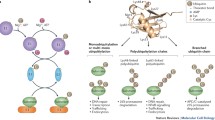Abstract
The capacity for exquisite regulation of ubiquitylation provides eukaryotic cells with a means to fine-tune both protein function and levels. This complex set of processes affects myriad proteins and potentially impacts all cellular processes. Ubiquitylation is brought about through multienzyme processes, with specificity conferred primarily by interactions of substrates with specific ubiquitin protein ligases (E3s) in association with ubiquitin conjugating enzymes (E2s). Regulation of ubiquitylation occurs at multiple levels, including E2-E3 interactions, substrate recognition, chain elongation, binding of ubiquitin to conserved motifs and deubiquityation. This review presents the fundamentals of the ubiquitin conjugating system.
Similar content being viewed by others
Author information
Authors and Affiliations
Corresponding author
Rights and permissions
About this article
Cite this article
Fang, S., Weissman, A.M. Ubiquitin-proteasome system. CMLS, Cell. Mol. Life Sci. 61, 1546–1561 (2004). https://doi.org/10.1007/s00018-004-4129-5
Issue Date:
DOI: https://doi.org/10.1007/s00018-004-4129-5




